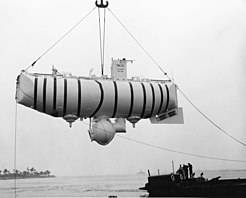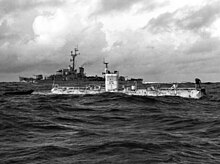Trieste
|
||||||||||||||
|
||||||||||||||
|
||||||||||||||
The Trieste was a bathyscaphe designed by Auguste Piccard , a submarine that was specially built for deep-sea research . Initial plans for this underwater vehicle developed Piccard in 1952, it was in Italy made from and on 26 August 1953 stack left. This vehicle was initially designed for diving depths of up to 20,000 feet (= 6,096 meters).
On September 30, 1953, the Trieste made a record dive in the Tyrrhenian Sea near Ponza . Auguste Piccard and his son Jacques Piccard reached a depth of 3,150 meters in their diving device. However, this record was surpassed in 1954 by the French bathyscaphe FNRS-3 , which dived 4050 meters off the coast of Senegal .
In 1958 the boat was taken over by the US Navy and was involved in several searches for lost ships and submarines, including the search for the lost nuclear submarine USS Thresher . From 1958, the vehicle was converted to be suitable for diving at greater depths.
The actual bathysphere (the pressure hull sphere ) was manufactured by the Krupp- Maschinenbau company in Essen . It now allowed diving trips up to a maximum of 36,000 feet (≈11,000 meters). A special safety feature was the part of the ballast, which consisted of several steel balls and was held by electromagnets . In the event of a power failure, the balls would have loosened immediately and the boat would have appeared on its own. Around 85 m³ of petrol in a cylindrical metal tank served as the buoyancy.
On January 23, 1960, the Trieste was the first submarine to reach Challenger Deep , one of the deepest places in the ocean , in the Mariana Trench at a depth of around 10,910 meters , and then to surface again. At this depth there is a pressure of over 1000 bar . The deepest point in the Pacific and in all of the world's oceans is Vitya Deep 1 . It is located about 1850 kilometers east of the Philippines 11 ° 19 ′ N , 142 ° 15 ′ E in the southwestern part of the Mariana Trench and is only about 112 meters lower than that of the then Trieste reached depth.
The crew only maneuvered the Trieste up to four meters above the sea floor , which probably served as a safety distance; the 10,910 meter sea depth (depending on the source a depth of 10,916 meters is also called) was the diving record of a submarine, until it was exceeded on April 28, 2019 by the " Five Deep " expedition with the submarine DSV Limiting Factor . After the dive, this deep sea was called the Trieste Deep . The inmates were the Swiss Jacques Piccard and the American Don Walsh .
Various reference works incorrectly indicate a depth of over 11,000 meters. The difference is due to the incorrect calibration of the depth gauge, which was carried out in fresh water.
After the boat was decommissioned, the pressure hull was reused and fitted into the successor Trieste II . The Trieste is now on display at the National Museum of the United States Navy in Washington, DC . A faulty test casting of the pressure hull was saved from scrapping in the 1960s at the Krupp factory in Essen. The interior was partly reconstructed with original spare parts in order to match the model as closely as possible. The cut model is now in the shipping department of the Deutsches Museum in Munich.
Web links
- Ariane Stürmer: deep intoxication in the eternal night. Legendary diving expedition. In: one day . January 21, 2010, accessed March 2, 2020 .
- Marc Tribelhorn: Journey into Eternal Darkness. In: Neue Zürcher Zeitung . January 26, 2015, accessed March 2, 2020 .
Individual evidence
- ↑ Augsburger Allgemeine from September 30, 2008
- ↑ Planet Earth , accessed on September 30, 2009
- ↑ Stephanie Fitzherbert: Deepest Submarine Dive in History, Five Deeps Expedition Conquers Challenger Deep. In: The 5 Deeps. The 6 Deeps, May 13, 2019, accessed May 14, 2019 .




